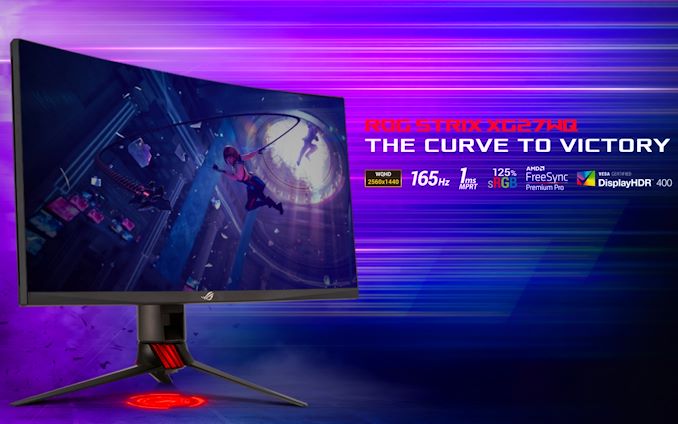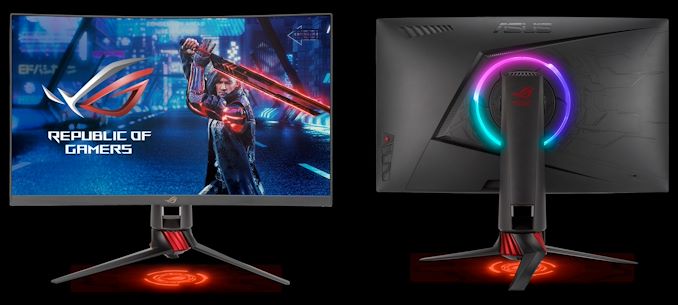ASUS Launches ROG Strix XG27WQ Curved 165Hz Monitor: FreeSync Premium Pro Certified
by Anton Shilov on April 2, 2020 11:30 AM EST
AMD’s FreeSync Premium Pro certification promises quite a lot when it comes to features and quality, but unfortunately there are less than a dozen of such displays available on the market today. Thankfully, that market will be getting one more entry courtesy of ASUS, who recently announced its second FreeSync Premium Pro monitor, the ROG Strix XG27WQ. Touting support for superior capabilities, the 27-inch monitor is one of the most feature-packed FreeSync Premium Pro monitors to date, and it promises to be less expensive than some of its larger rivals.
The ASUS ROG Strix XG27WQ monitor relies on a curved 27-inch VA panel with a 2560×1440 resolution. All together, the monitor offers a peak brightness of 450 nits, a 3000:1 contrast ratio, 178°/178° horizontal/vertical viewing angles, a 1 ms MPRT response time, and a 165 Hz maximum refresh rate. The LCD offers one DisplayPort 1.2 inputs and two HDMI 2.0 to connect to its host and also has a dual-port USB 3.0 hub along with a headphone output.
AMD mandates FreeSync Premium Pro (previously FreeSync 2) monitors to support a wide variable refresh rate range (48 – 144 Hz or 48 – 165 Hz in case of the XG27WQ), feature Low Framerate Compensation, be capable of low-latency tone mapping to the monitor’s native color space, meet HDR brightness and and contrast requirements roughly equivalent to DisplayHDR 500, and reproduce at least 90% of the DCI-P3 color gamut (92% in the ROG's case). The capabilities of the ASUS ROG Strix XG27WQ monitor actually exceed AMD’s requirements, which makes it a rather potent choice for gamers.
In addition to VESA’s Adaptive-Sync/AMD’s FreeSync VRR, the display also supports ASUS’s Extreme Low Motion Blur (ELMB) that makes fast-paced scenes look sharper even when a variable refresh rate technology is enabled. The ROG Strix XG27WQ also supports a variety of genre-specific game modes, ASUS's Shadow Boost feature to make dark scenes look brighter, and enhancements like crosshair overlay for easier targeting in FPS titles.
Since we are dealing with an ASUS ROG-branded monitor, the model Strix XG27WQ not only features a stand that can adjust height, tilt, and swivel, but also one that has Aura Sync addressable RGB lighting as well as a projector that projects a logotype onto the table below.
| The ASUS ROG Strix XG27WQ | |
| General Specifications | |
| Panel | 27" VA |
| Native Resolution | 2560 × 1440 |
| Maximum Refresh Rate | 165 Hz |
| Response Time | 1 ms MPRT |
| Brightness | 450 cd/m² (peak) |
| Contrast | 3000:1 |
| Backlighting | LED |
| Viewing Angles | 178°/178° horizontal/vertical |
| Curvature | 1500R |
| Aspect Ratio | 16:9 |
| Color Gamut | 125% sRGB/BT.709 92% DCI-P3 |
| DisplayHDR Tier | 400 |
| Dynamic Refresh Rate Tech | AMD FreeSync Premium Pro DisplayPort: 48 - 165 Hz HDMI: 48 - 144 Hz |
| Pixel Pitch | 0.2331 mm² |
| Pixel Density | 108 PPI |
| Inputs | 1 × DisplayPort 1.2 2 × HDMI 2.0 |
| Audio | 3.5 mm output |
| USB Hub | 2 × USB 3.0 Type-A connectors 1 × USB 3.0 Type-B input |
| Stand | Swivel: -50° ~ +50° Tilt: -5° ~ +20° Height: 100 mm VESA: 100x100 |
| MSRP | ? |
Finally, it's worth keeping in mind that ASUS sometimes formally introduces its products well ahead of their actual release date. As things currently stand, the company has not revealed anything about an actual launch date or pricing for ROG Strix XG27WQ, so it remains to be seen when the monitor will actually hit the streets.
Related Reading:
- AMD Announces FreeSync 2: Easier & Lower Latency HDR Gaming
- Dell Rolls Out 32-Inch QHD Curved Gaming Monitor (S3220DGF): Up To 165Hz with FreeSync 2
- HP's Omen X 27: A 240Hz QHD Monitor with FreeSync 2 HDR
- GIGABYTE’s Aorus CV27Q Curved ‘Tactical’ Monitor: 165 Hz QHD With FreeSync 2
- AOC Reveals Agon AG273QX: A 27-Inch 165 Hz FreeSync 2 Monitor
Source: ASUS (via Hermitage Akihabara)











39 Comments
View All Comments
edzieba - Friday, April 3, 2020 - link
No wonder they changed the name from "Freesync 2 HDR" to "Freesync Premium Pro": they eliminated any requirement to actually implement HDR.'DisplayHDR 500' could be replaced with "not HDR in any way, shape or form", as it mandates brightness and static contrast ratios no different than SDR displays (and no, edge-zones do not count any more than 'dynamic contrast' is worth a damn). Just accepting a HDR input and displaying it as SDR is as worthless as a 960x540 monitor that accepts a 1920x1080 input and calls itself 'HD capable'.
mode_13h - Friday, April 3, 2020 - link
Where do you see that? According to them, Pro adds the following qualifications over Premium:* Low latency in SDR and HDR
* Support for HDR with meticulous color and luminance certification
Source: https://www.amd.com/en/technologies/free-sync
Further, they say:
"In the case of FreeSync Premium Pro, the display passes specifications and data straight to the PC. This allows games to directly tone map to the display, skipping bulky intermediate steps and helping reduce input latency. Furthermore, the baseline HDR requirements in FreeSync Premium Pro are greater than HDR 400 to provide at least twice the perceived color volume as SDR (sRGB)."
Source: https://www.amd.com/en/technologies/free-sync-faq
edzieba - Monday, April 6, 2020 - link
Right here:"Furthermore, the baseline HDR requirements in FreeSync Premium Pro are greater than HDR 400 to provide at least twice the perceived color volume as SDR (sRGB)."
Increasing colour volume is basically worthless on its own. HDR stands for High Dynamic Range (high static contrast ratio), and shifting your colour primaries out a bit does nothing whatsoever to increase dynamic range.
'HDR 400' is a pure joke: https://www.tftcentral.co.uk/blog/why-your-hdr-mon...
mode_13h - Tuesday, April 7, 2020 - link
Thanks for the info.I like the fact that this is a true 10-bit display. Sure 450 nits and 3000:1 static contrast aren't ideal, but it's enough to avoid banding or the added noise of FRC, and that's a good thing. And 92% DCI-P3 exceeds what that article is calling for.
Also, I worry about FALD artifacts. I'd rather go straight to an emissive display technology, like OLED. I really wanted my next monitor to be OLED, but I've long lost hope of that happening.
edzieba - Tuesday, April 7, 2020 - link
8bit + FRC is not going to be visually distinguishable from 10bit at a mere 3000:1 at 450 nits unless you're doing cinematic colour grading (where a shot may plausibly be a full-screen blue-to-very-slightly-less-blue gradient). A wide colour gamut alone is practically worthless for an SDR screen outside of a calibrated toolchain: the lack of any functional HDR means any HDR content that may happen to use a wider gamut will be displayed completely incorrectly, as will any non-HDR content unless the monitor is switched to sRGB mode.mode_13h - Wednesday, April 8, 2020 - link
Freesync Premium Pro is supposed to communicate the gamut of the display device to the source, so that software can tone-map the content to fit the display's gamut. So, I don't follow why it would would be "displayed completely incorrectly".edzieba - Wednesday, April 8, 2020 - link
Because there is more to colour display than just gamut. The entire point of HDR is that High Dynamic Range, and if you do not have a high dynamic range to actually display to then you're getting an incorrect presentation. Just as accepting a 3840x2160 signal and displaying it on a 960x540 panel will technically 'work;' but be funtionally pointless beyond a '4K support!' box sticker, a 'HDR' monitor that cannot display HDR is jsut a marketing checkbox rather than a usable feature.dgingeri - Friday, April 3, 2020 - link
I think I'd like it better if it didn't have that horrible stand.mode_13h - Friday, April 3, 2020 - link
The stand is probably okay without the LEDs turned on.I wonder how many people actually want that stupid ROG logo projected on their desk (I'm guessing close to zero). More interesting would be to know how many people ASUS *thinks* want to see it.